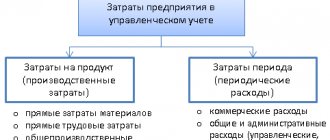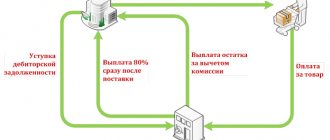Accounting rules: what they are and why they are needed
PBUs or accounting regulations (sometimes informally referred to as accounting rules) are regulations that establish the procedure for preparing financial statements and maintaining accounting in one or another area of a company’s business activities.
PBUs can regulate the specifics of accounting for various assets, liabilities, and individual facts of economic activity. Many PBUs are being replaced by federal accounting standards or FSBU.
Find out what standards to rely on when doing accounting here.
Accounting standards are generally issued by the Ministry of Finance of the Russian Federation, and for credit organizations - by the Bank of Russia. All organizations must comply with the standards established by the PBU, unless exceptions are expressly stated in a particular provision. For example, paragraph 3 of PBU 8/2010 states that the rules enshrined in the relevant source may not be applied by organizations that use simplified accounting schemes. These include, in particular, small businesses, non-profit organizations and other entities (information of the Ministry of Finance dated June 29, 2016 No. PZ-3/2016).
In 2022 - 2022 in the Russian Federation, a different number of accounting standards are applied that determine the accounting rules. Let's take a closer look at them.
PBU 15/2008 “Accounting for expenses on loans and credits”
Approved by Order of the Ministry of Finance of the Russian Federation dated October 6, 2008 N 107n
ACCOUNTING REGULATIONS ON LOANS AND CREDITS” (PBU 15/2008)
List of amending documents (as amended by Orders of the Ministry of Finance of Russia dated October 25, 2010 N 132n, dated November 8, 2010 N 144n, dated April 27, 2012 N 55n, dated April 6, 2015 N 57n)
I. General provisions
1. These Regulations establish the specifics of the formation in accounting and financial statements of information on expenses associated with the fulfillment of obligations on loans received (including raising borrowed funds by issuing bills, issuing and selling bonds) and loans (including commodity and commercial), organizations that are legal entities under the legislation of the Russian Federation (with the exception of credit organizations and state (municipal) institutions).
2. The principal amount of the obligation for the loan (credit) received is reflected in the accounting records of the borrowing organization as accounts payable in accordance with the terms of the loan agreement (credit agreement) in the amount specified in the agreement.
3. Expenses associated with fulfilling obligations under received loans and credits (hereinafter referred to as loan expenses) are:
interest due to the lender (creditor);
additional borrowing costs.
Additional borrowing costs are:
amounts paid for information and consulting services;
amounts paid for the examination of a loan agreement (credit agreement);
other expenses directly related to obtaining loans (credits).
4. Loan expenses are reflected in accounting separately from the principal amount of the obligation for the loan (credit) received.
5. Repayment of the principal amount of the obligation for a loan (credit) received is reflected in the accounting records of the borrowing organization as a reduction (repayment) of accounts payable.
II. Procedure for accounting for borrowing costs
6. Loan expenses are reflected in accounting and reporting in the reporting period to which they relate.
7. Borrowing expenses are recognized as other expenses, with the exception of that part of them that is subject to inclusion in the cost of the investment asset, unless otherwise established by this paragraph.
The cost of an investment asset includes interest payable to the lender (creditor) directly related to the acquisition, construction and (or) production of the investment asset.
For the purposes of these Regulations, an investment asset is understood as an object of property, the preparation of which for its intended use requires a long time and significant expenses for acquisition, construction and (or) production. Investment assets include objects of work in progress and construction in progress, which will subsequently be accepted for accounting by the borrower and (or) customer (investor, buyer) as fixed assets (including land), intangible assets or other non-current assets.
Organizations that have the right to use simplified accounting methods, including simplified accounting (financial) reporting, can recognize all borrowing costs as other expenses.
8. Interest payable to the lender (creditor) is included in the cost of the investment asset or other expenses evenly, as a rule, regardless of the terms of the loan (credit). Interest payable to the lender (creditor) may be included in the cost of the investment asset or as part of other expenses based on the terms of the loan (credit) in the case where such inclusion does not differ significantly from equal inclusion.
Additional borrowing costs may be included evenly as part of other expenses during the term of the loan (loan agreement).
9. Interest payable to the lender (creditor) is included in the cost of the investment asset if the following conditions are met:
a) expenses for the acquisition, construction and (or) production of an investment asset are subject to recognition in accounting;
b) borrowing costs associated with the acquisition, construction and (or) production of an investment asset are subject to recognition in accounting;
c) work has begun on the acquisition, construction and (or) production of an investment asset.
10. Interest payable to the lender (creditor) associated with the acquisition, construction and (or) production of an investment asset is reduced by the amount of income from the temporary use of funds received from loans (credits) as long-term and (or) short-term financial investments.
11. When the acquisition, construction and (or) production of an investment asset is suspended for a long period (more than three months), interest payable to the lender (creditor) ceases to be included in the cost of the investment asset from the first day of the month following the month of suspension of the acquisition, construction and/or manufacturing of such an asset.
During the specified period, interest payable to the lender (creditor) is included in other expenses of the organization.
When renewing the acquisition, construction and (or) production of an investment asset, interest payable to the lender (creditor) is included in the cost of the investment asset from the first day of the month following the month of resumption of acquisition, construction and (or) production of such an asset.
The period during which additional approval of technical and (or) organizational issues that arose in the process of acquisition, construction and (or) production of an investment asset is not considered a period of suspension of the acquisition, construction and (or) production of an investment asset.
12. Interest payable to the lender (creditor) ceases to be included in the cost of the investment asset from the first day of the month following the month of termination of the acquisition, construction and (or) production of the investment asset.
13. If an organization begins to use an investment asset for the manufacture of products, performance of work, provision of services despite the incompleteness of work on the acquisition, construction and (or) production of the investment asset, then the interest due for payment to the lender (creditor) ceases to be included in the cost of such an asset from the first day of the month following the month in which the investment asset began to be used.
14. If funds from loans (credits) received for purposes not related to such acquisition, construction and (or) production are spent on the acquisition, construction and (or) production of an investment asset, then the interest payable to the lender (creditor) ), are included in the cost of the investment asset in proportion to the share of these funds in the total amount of loans (credits) payable to the lender (creditor), received for purposes not related to the acquisition, construction and (or) production of such an asset.
An example of calculating the share of interest payable to the lender (creditor) to be included in the cost of an investment asset
List of PBUs on accounting in 2021-2022
The accounting rules applied in the Russian Federation in 2021-2022 are presented in the following list:
- PBU 7/98 - establishes the procedure for reflecting events after the reporting date in accounting;
- PBU 4/99—establishes the methodological basis for financial reporting of legal entities;
- PBU 9/99 - establishes the procedure for reflecting income in the accounting of organizations;
- PBU 10/99 - fixes the procedure for reflecting expenses in the accounting of legal entities;
Read about PBU 9/99 and 10/99 here .
- PBU 13/2000 - regulates the reflection in accounting of information on state assistance to commercial firms;
- FSBU 5/2019 (until 2022 - PBU 5/01) - regulates the reflection of inventories in accounting;
Find out what nuances should be taken into account when applying the accounting standard FSBU 5/2019 in the Review from ConsultantPlus. To do everything right, get trial access to the system and study the material for free.
- FSBU 6/2020 “Fixed assets” and FSBU “Capital investments” (until 2022 - PBU 6/01) - establishes the rules for reflecting fixed assets and capital investments in accounting;
PBU 6/01 has become invalid since 01/01/2022. Instead, two new FSBUs were introduced: 6/2020 “Fixed Assets” and 26/2020 “Capital Investments”. ConsultantPlus experts explained in detail what the new standards have changed compared to PBU 6/01. Get trial demo access to the K+ system and upgrade to the Ready Solution for free.
- PBU 16/02 - regulates the disclosure of information on discontinued activities in accounting;
- PBU 17/02 - regulates the reflection of information on expenses for scientific research in accounting;
- PBU 18/02—establishes the rules for reflecting information on income tax calculations in accounting;
ConsultantPlus experts explained in detail how to apply PBU 18/02 when permanent and temporary differences arise between accounting and tax accounting. Get trial access and go to the Ready solution.
- PBU 19/02—regulates the rules for reflecting financial investments in accounting;
- PBU 20/03 - establishes the rules for reflecting in accounting information about the participation of a business entity in joint activities;
- PBU 3/2006—regulates the reflection in accounting of information about the assets and liabilities of a company in foreign currency;
- PBU 14/2007 - establishes the rules for reflecting information about intangible assets in accounting;
- PBU 1/2008—defines how an enterprise should formulate and disclose accounting policies;
- PBU 2/2008 - establishes rules for disclosing in accounting information about the activities of construction contractors (or subcontractors);
- PBU 11/2008 - establishes how to disclose information about related parties in reporting;
- PBU 15/2008 - establishes how to reflect in accounting information about expenses on loans and borrowings;
- PBU 21/2008 - establishes how to disclose information about changes in estimated values in reporting;
- PBU 8/2010 - regulates how estimated and contingent liabilities, as well as contingent assets, should be reflected in accounting;
- PBU 12/2010 - establishes the procedure for reflecting information by segments in the accounting records of organizations;
- PBU 22/2010 - regulates the procedure for correcting errors and reflecting information about them in accounting;
- PBU 23/2011 - regulates how a cash flow statement should be prepared;
- PBU 24/2011 - establishes the procedure for reflecting information on expenses for the development of natural resources in accounting.
FSBU 25/2018 “Rent”, approved by order of the Ministry of Finance of Russia dated October 16, 2018 No. 208n, must be applied from 2022. You can read about it here.
From 2022, FAS 27/2021 “Documents and document flow in accounting” is also mandatory. Read how to implement the new standard here.
New PBU for loan accounting. Brevity for clarity
New PBU 15/2008 “Accounting for expenses on loans and credits”
, approved by order of the Ministry of Finance of the Russian Federation dated October 6, 2008 No. 107n, will need to be applied starting with reporting
for 2009
.
That is, until the end of 2008, accounting is carried out according to the old rules (according to PBU 15/01 “Accounting for loans and credits and the costs of servicing them,” approved by order of the Ministry of Finance of the Russian Federation dated August 2, 2001 No. 60n), and already for
the first quarter of 2009
financial statements must be prepared taking into account the norms of PBU 15/2008.
In general, the new PBU 15/2008 is shorter than its predecessor, but this does not add clarity, rather the opposite.
Interest-free loans and government loans
The previous PBU 15/01 was not applied to interest-free loan agreements and government loan agreements.
At the same time, a special procedure for accounting for expenses on interest-free loans
was absent.
In this regard, these expenses were still taken into account by analogy
with the procedure provided for by PBU 15/01.
There are no such restrictions in the new PBU 15/2008, which means that the provisions of PBU 15/2008 will be legally applied to interest-free loan agreements.
Regarding government loan
, then the Russian Federation, and not the organization, is the borrower.
The organization under government loan agreements is the lender
, that is, does not receive a loan, but issues it.
A government loan agreement is concluded through the acquisition by the lender (that is, the organization) of issued government bonds or other government securities certifying the lender’s right to receive from the borrower the funds lent to him or, depending on the terms of the loan, other property, established interest or other property rights within the terms stipulated by the conditions for issuing a loan into circulation ( Article 817 of the Civil Code of the Russian Federation
).
cannot reflect government loans as part of borrowed funds.
.
Therefore, despite the absence of a direct ban on the application of the provisions of PBU 15/2008 to government loans, it is impossible to take into account government loans according to the norms of this PBU.
Amount of debt – actual or contractual
In accordance with PBU 15/01, the principal amount of debt on a loan and (or) an organization’s loan received from the lender should have been taken into account in accordance with the terms of the loan agreement or credit agreement in the amount of funds actually received
or in the valuation of other things provided for in the contract.
Moreover, the specified debt should have been taken into account at the time of actual transfer
money or other things.
With regard to accounting for debt under loan agreements, the provisions of PBU 15/01 are applicable.
The loan agreement is real
, which means that it is considered concluded from the moment
of transfer of money
or other things, that is, when the parties carry out real actions to execute the contract.
But a credit agreement, unlike a loan agreement, is consensual, that is, the rights and obligations of the parties to such an agreement arise at the time of its conclusion, and not at the time of actual execution (transfer of money).
That is, the borrower’s actual debt under the loan agreement arises on the date of conclusion of the agreement, so it should be reflected in accounting without waiting for the actual transfer of funds and in the amount specified in the agreement, which is what the new PBU 15/2008 prescribes.
Since January 1, 2009
The principal amount of the obligation for the loan (credit) received will be reflected in the accounting records of the borrowing organization as accounts payable in accordance
with the terms of the loan agreement
(credit agreement)
in the amount specified in the agreement
.
That is, firstly, the amount of debt on monetary loans (credits) will be determined by the terms of the agreement, and not by the amount of funds actually received, and secondly, the moment of reflection in the accounting of debt will also depend on the terms of the agreement, and not on the moment of actual transfer of money.
Moreover, under loan agreements, the debt should still be reflected at the time of the actual transfer of money or other things, because this agreement, as already said, is real and begins to take effect only when the money is transferred.
This means in accordance with the terms of the contract
(as stated in PBU 15/2008), debt under a loan agreement arises with the borrower precisely at the moment of actual transfer of money.
Is it long or short?
PBU 15/01
prescribes dividing the debt on received loans and borrowings in accounting into short-term and long-term.
Short-term debt
is considered to be debt on received loans and credits, the repayment period of which, according to the terms of the agreement, does not exceed 12 months.
Long-term debt
is considered to be debt on received loans and credits, the repayment period of which, according to the terms of the agreement, exceeds 12 months.
translation is allowed
long-term debt into short-term debt, which allows you to improve some of the financial performance indicators of the organization.
does not contain similar provisions
.
However, this is not a reason to believe that the division of debt into long-term and short-term is abolished.
Such a division will need to be made, at least until the instruction is taken into account separately
short-term and long-term debt are contained in the Instructions for the use of the Chart of Accounts, approved by order of the Ministry of Finance of the Russian Federation dated October 31, 2000 No. 94n.
Let us remind you that the Chart of Accounts provides for the maintenance of two synthetic accounts for accounting for debt on loans and borrowings: depending on the period for which the borrowed funds were received (up to 12 months inclusive or more than 12 months).
Settlements for them are carried out, respectively, either on account 66
“Settlements for short-term loans and borrowings”, or
on account 67
“Settlements for long-term loans and borrowings”.
In addition, Form No. 1
The “balance sheet” also provides for the reflection in the liabilities side of the balance sheet of information about loans and credits, both as part of long-term liabilities (Section IV of the balance sheet) and as part of short-term liabilities (Section V of the balance sheet) - depending on the period for which the borrowed funds were received.
But about the transfer of long-term debt to short-term debt from January 1, 2009
. you will have to forget: such a translation is mentioned only in PBU 15/01 and no other regulatory document mentions this possibility.
Also in PBU 15/2008 (unlike PBU 15/01) there is no division of debt into urgent and overdue.
Although the Instructions for using the Chart of Accounts still require that they be taken into account separately
loans and borrowings not paid on time.
So essentially nothing has changed in this part either.
Interest on bills and exchange rate differences
PBU 15/01
provides for the inclusion in the costs associated with the receipt and use of loans and borrowings, expenses in the form of
interest (discount)
on bills and bonds due for payment and
exchange rate differences
related to interest payable on loans and credits received and denominated in foreign currency or conventional monetary units formed from the moment interest is accrued under the terms of the agreement until their actual repayment (transfer).
PBU 15/2008 does not directly name such expenses.
PBU 15/2008 only talks about expenses in the form of interest
payments due to the lender (creditor), and
additional
borrowing costs.
However, bills and bonds according to Art. 815
and
816 of the Civil Code of the Russian Federation
are just ways to draw up a loan agreement.
So interest (discount)
for bills and bonds - this is essentially the same interest under the loan agreement payable to the lender, which is mentioned in PBU 15/2008.
As for exchange rate differences, their accounting is spelled out in detail in PBU 3/2006 “Accounting for assets and liabilities, the value of which is expressed in foreign currency.”
In particular, PBU 3/2006 obliges the recalculation of funds in settlements, including for borrowed obligations expressed in foreign currency, into rubles on the date of the transaction in foreign currency, as well as on the reporting date, and to reflect the exchange rate differences arising in connection with this in composition of other income and expenses.
In this regard, the Ministry of Finance considered it inappropriate to prescribe the procedure for accounting for exchange rate differences additionally in PBU 15/2008.
Additional expenses
List of additional costs
, contained in PBU 15/01, is broader than the similar list from the new PBU 15/2008.
In particular, PBU 15/01 lists as additional costs the costs associated with:
– carrying out copying and duplicating work;
– payment of taxes and fees (in cases provided for by current legislation);
– consumption of communication services.
In PBU 15/2008 these costs are not listed as additional expenses.
However, in both PBU 15/01 and PBU 15/2008 the list of additional costs is open
.
This means that in 2009 and subsequent years, as now, it will be possible to take into account both the costs of copying and duplicating work, paying taxes and communication services, as well as other costs directly related to obtaining loans (credits).
As now, additional expenses according to PBU 15/2008 can be recognized as other expenses
in the reporting period to which they relate, or be included
evenly
in other expenses during the term of the loan (credit agreement).
Interest: together or separately
PBU 15/01 prescribes showing debt on loans and credits received, taking into account
interest due at the end of the reporting period.
In PBU 15/2008, there was an indication that borrowing costs are reflected in accounting separately from the principal amount of the obligation for the loan (credit) received.
However, the requirement for separate accounting of interest is contained in the Instructions for using the Chart of Accounts.
That is, in essence, interest accounting, as now, will be carried out separately.
Only others, no MPZ
PBU 15/01 states that the costs of loans and credits received may be included in other expenses or in the cost of investment assets.
In addition, with regard to MPZ, PBU 15/01 provides another option for accounting for costs of borrowings and credits.
If an organization uses funds from received loans and credits to make advance payments for inventories
, other valuables, works, services or the issuance of advances and deposits towards their payment, then the costs of servicing these loans and credits are attributed by the borrower organization
to the increase in receivables
generated in connection with the prepayment and (or) issuance of advances and deposits for the specified above the target.
Then, when the borrower’s organization receives inventories and other valuables, performs work and provides services, further accrual of interest and other expenses associated with servicing received loans and credits are reflected in accounting in the general manner
– with the attribution of these costs to other expenses of the borrowing organization.
PBU 15/2008 does not provide for the inclusion of costs for loans and borrowings in the cost of inventories: according to PBU 15/2008, borrowing costs are recognized as other expenses
, with the exception of that part of them that is subject to inclusion in the value of the investment asset.
However, PBU 5/01 “Accounting for inventories”, approved by order of the Ministry of Finance of the Russian Federation dated 06/09/2001 No. 44n, stipulates that interest on borrowed funds accrued before the acceptance of inventories for accounting, if they are raised for the acquisition of these inventories are the actual costs of purchasing inventories and are included in the actual cost
inventories purchased for a fee.
A legal conflict arises: two norms of different PBUs contradict each other.
In this case, you should be guided by the norms of the document later
by date of adoption, in the case under consideration - this is PBU 15/2008.
Note!
Thus, borrowing costs since 2009
must be recognized
as other expenses
and cannot be included in the cost of inventories.
The only exception to this rule is those borrowing costs that are included in the cost of investment assets.
Let's consider this point in more detail.
Investment assets
For the purposes of PBU 15/2008,
an investment asset
is understood as an object
of property
, the preparation of which for its intended use requires a long time and significant costs for acquisition, construction and (or) production.
Investment assets include objects of work in progress and construction in progress, which will subsequently be accepted for accounting by the borrower and (or) customer (investor, buyer) as fixed assets (including land), intangible assets or other non-current assets.
The definition of investment assets is also contained in PBU 15/01, and in the new PBU 15/2008
it is presented in a clearer and more complete form.
But if currently the specified objects are purchased directly for resale
, are accounted for as goods and
do not belong
, then PBU 15/2008 directly states that objects of unfinished production or construction that will be accepted for accounting
by the customer
(investor,
buyer
) are also considered investment assets.
Interest, not costs
PBU 15/01 provides for the inclusion of costs
for loans and credits directly related to the acquisition and (or) construction of investment assets.
costs include
may include both
interest
due to the lender and other additional costs.
New PBU 15/2008
prescribes that the value of investment assets should include only
interest
due to the lender (creditor).
That is, additional costs
cannot
be included in the value of investment assets , and are taken into account in the manner prescribed on page 20.
PBU 15/2008
clearly formulates the conditions for including interest in the value of an investment asset:
A)
expenses for the acquisition, construction and (or) production of an investment asset are subject to recognition in accounting;
b)
borrowing costs associated with the acquisition, construction and (or) production of an investment asset are subject to recognition in accounting;
V)
work has begun on the acquisition, construction and (or) production of an investment asset.
Like PBU 15/01, PBU 15/2008 establishes that when the acquisition, construction and (or) production of an investment asset is suspended for a long period (more than three months), interest payable to the lender (creditor) ceases to be included in the cost of the investment asset .
PBU 15/2008
clarifies that the inclusion of interest in the cost of an investment asset should be stopped
from the first day
of the month following the month of suspension of the acquisition, construction and (or) production of such an asset.
During the specified period, interest payable to the lender (creditor) is included in other expenses of the organization.
But PBU 15/01 does not explain how to take into account the costs of credits and borrowings if the process of acquiring, constructing or manufacturing an investment asset is resumed
.
PBU 15/2008
fills this gap.
Upon resumption
acquisition, construction and (or) production of an investment asset, interest payable to the lender (creditor) is included in the cost of the investment asset from the first day of the month following the month of resumption of acquisition, construction and (or) production of such an asset.
If the goal has changed
It happens that funds from loans and borrowings received for purposes unrelated
with such an acquisition (for example, loan funds received to replenish working capital).
PBU 15/01 prescribes including in the cost of investment assets the costs of such “non-targeted” borrowed funds. This should be done at a weighted average cost rate
.
PBU 15/2008
also prescribes interest payable to the lender (creditor) to be included in the cost of the investment asset in proportion to the share of
such
“non-targeted” borrowed funds in the total amount of loans (credits) payable to the lender (creditor), received for purposes not related to the acquisition, construction and (or) production of such an asset.
The procedure for calculating the share of interest payable to the lender (creditor), subject to inclusion in the cost of an investment asset, is explained in PBU 15/2008 in the form of an example
.
| Index | Amount of loans (credits), rub. | ||
| Total | including | ||
| for the acquisition, construction and (or) production of an investment asset | for common purposes | ||
| Balance of unused loans (credits) at the beginning of the reporting period | 10 000 | 6 000 | 4 000 |
| Loans (credits) received during the reporting period | 40 000 | 30 000 | 10 000 |
| Total loans (credits) in the reporting period | 50 000 | 36 000 | 14 000 |
| Interest to be accrued in the reporting period | 10 800 | 9 100 | 1700 |
| Loans (credits) spent in the reporting period | 48 000 | 44 000 | 4 000 |
Loans (credits) spent in the reporting period on the acquisition, construction and (or) production of an investment asset from loans (credits) received for general purposes: 8,000 = (44,000 – 36,000).
The amount of interest payable to the lender (creditor) for loans (credits) received for general purposes, to be included in the value of the investment asset: 971 = (1,700 x 8,000) / 14,000.
Total amount of interest payable to the lender (creditor), subject to inclusion in the value of the investment asset: 10,071 = (9,100 + 971).
Note for example:
1.
The amount of interest payable to the lender (creditor), subject to inclusion in the cost of the investment asset, must not exceed the total amount of interest payable to the lender (creditor), organization in the reporting period.
2.
When calculating the share of interest payable to the lender (creditor) to be included in the cost of the investment asset, the amount of loans (credits) received for the acquisition, construction and (or) production of the investment asset is excluded from the total amount of loans (credits).
3.
The amount of interest payable to the lender (creditor), subject to inclusion in the cost of several investment assets, is distributed among investment assets in proportion to the amount of loans (credits) included in the cost of each investment asset.
4.
The calculation of the share of interest on loans to be included in the cost of the investment asset given in this example is based on the following assumptions:
A)
rates on all loans (credits) are the same and do not change during the reporting period;
b)
work on the acquisition, construction and (or) production of an investment asset continues after the end of the reporting period.
Calculations made by organizations may be based on different assumptions.
Interest accounting procedure
PBU 15/01 establishes that the inclusion of borrowing and credit costs in current expenses is carried out in the amount of payments due in accordance with loan agreements and credit agreements concluded by the organization
regardless of in what form and when the specified payments are actually made.
The procedure for including the costs of loans and borrowings in the cost of investment assets PBU 15/01 is not specified at all.
But from clause 16 of this PBU (according to which the organization accrues interest on loans and credits received in accordance with the procedure established in the agreement
loan and (or) credit agreement), we can conclude that interest is included in the cost of investment assets in accordance with
the terms of the agreement
.
New PBU 15/2008
provides that interest payable to the lender (creditor) is included in the cost of the investment asset or other expenses
evenly
, as a rule,
regardless
of the terms of the loan (credit) (that is, regardless of the terms of the agreement).
Interest payable to the lender (creditor) may be included in the cost of the investment asset or as part of other expenses based on the conditions
provision of a loan (credit) (that is, based on the terms of the agreement) in the case where such inclusion
does not differ significantly
from uniform inclusion.
Bills and bonds
The procedure for accounting for interest on bills and bonds remains essentially the same: interest accrued on the bill amount, accrued interest and (or) discount on the bond are reflected by the drawer (issuer) as part of other expenses in those reporting periods to which these accruals relate, or
evenly throughout the period for repayment of borrowed funds stipulated by the bill of exchange (during the term of the loan agreement).
PBU 15/2008 clarifies that interest and (or) discount should be reflected separately
from the bill amount and the face value of the bond as accounts payable.
Disclosure of information in accounting policies
PBU 15/2008
, unlike PBU 15/01,
does not provide
a list of information that must be disclosed in the accounting policy.
However, this does not mean that the accounting policy will no longer have to write anything about how the costs of credit and borrowings are taken into account.
After all, PBU 15/2008 provides for variability, for example, in the order of writing off additional expenses on loans, in accounting for interest on bills and bonds, etc.
These points will still need to be recorded in the accounting policies based on the requirements of PBU 1/2008.
Disclosure of information in financial statements
In addition to the information required to be disclosed in the financial statements by PBU 15/01, PBU 15/2008
obliges to report also about:
– about the amounts of income
from the temporary use of funds from a received loan (credit) as long-term and (or) short-term financial investments, including those taken into account when reducing borrowing costs associated with the acquisition, construction and (or) production of an investment asset;
interest included in the cost of the investment asset
, due for payment to the lender (creditor), for loans taken for purposes not related to the acquisition, construction and (or) production of an investment asset.
New PBUs in 2021–2023
The Ministry of Finance is conducting a global development of federal accounting standards for 2021–2023. According to the order of the Ministry of Finance dated 06/05/2019 No. 83n, new PBUs will be developed and amendments will be made to the already published provisions. The plan for the development and implementation of innovations is shown in the table below.
| No. | PBU project name | Estimated effective date for mandatory application |
| Development of new federal standards | ||
| 1.1 | Reserves | 2021 |
| 1.2 | Intangible assets | 2021 |
| 1.3 | OS | 2021 |
| 1.4 | Unfinished capital investments | 2021 |
| 1.5 | Documents and document flow | 2021 |
| 1.6 | Non-profit activities | 2021 |
| 1.7 | Financial statements | 2021 |
| 1.8 | Income | 2022 |
| 1.9 | Participation in affiliated organizations and joint activities | 2022 |
| 1.10 | Financial instruments | 2022 |
| 1.11 | Debt costs | 2022 |
| 1.12 | Expenses | 2023 |
Results
The procedure for reflecting information about various facts and results of economic activities of business entities in accounting is regulated by separate sources of law - PBU. Over time, they will be replaced by new accounting regulations - federal standards.
You can learn more about the specifics of PBU from the articles:
- “Accounting for currency transactions (PBU, postings)”;
- “What are the main differences between PBU and IFRS?”.
You can find more complete information on the topic in ConsultantPlus. Free trial access to the system for 2 days.







